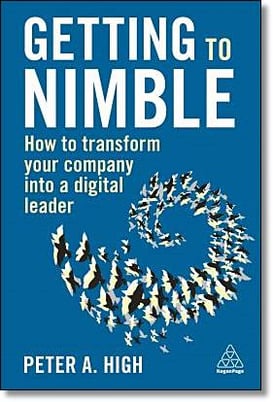This excerpt from Getting to Nimble is ©2021 and reproduced with permission from Kogan Page Ltd.
In December 2016, I visited Shamim Mohammad, then the senior vice president and chief information officer of CarMax. In November 2018, he would add the chief technology officer role to his responsibilities. He gave me a tour of his digital lab at the Shockoe Bottom neighborhood of Richmond, Virginia, within walking distance of the city’s downtown area and about 20 miles away from the company’s headquarters. We sat for an interview, and I concluded it with a question I ask most of my interviewees. It is some version of, “What trends excite you as you look to the future?” Mohammad offered thoughts on cloud computing, machine learning, and blockchain. Then he said something that stuck with me:
 "I do not know how the world is going to be in three or four years. It is hard to predict. What I am trying to do as CIO is position [CarMax] so that we are ready to take those changes and be nimble, agile, and responsive: an organization that can move quickly. That is what I do because I cannot predict what is going to happen. I have to position [CarMax] to be that nimble company."
"I do not know how the world is going to be in three or four years. It is hard to predict. What I am trying to do as CIO is position [CarMax] so that we are ready to take those changes and be nimble, agile, and responsive: an organization that can move quickly. That is what I do because I cannot predict what is going to happen. I have to position [CarMax] to be that nimble company."
This was poignant, and it struck me immediately. Having asked a version of that question to roughly 500 people (as of this writing), he is the only one to speak so directly about the need to reorient the technology and digital function to be a source of nimbleness. I thought about his answer for much of the drive back from Richmond to my home in the Washington, DC area.
Nimbleness is, in many ways, the greatest value a technology or digital organization can offer to a company. The ability to pivot quickly to seize opportunities or to stave off issues is important now more than ever during a time when the pace of change has never been faster, and yet it will never be this slow again.
Measuring Your Nimbleness
The stories of leading companies, both their cautionary tales and their stories of rebirth, are enlightening, providing a guide for digital immigrant companies (those born before the digital age) to compete. In the case of companies like The Washington Post and Domino’s, these companies had to rethink five factors in order to better compete:
- People
- Processes
- Technologies
- Ecosystem
- Strategy and innovation
1. People
It is a truism to say that people are a company’s most important asset, and yet many companies do not think enough about how to attract, retain, and grow the best talent. Moreover, many team members are not given, or do not seize, opportunities that are presented to grow their skills in a way that reflects where the business and technology landscape is going.
The concept of nimbleness begins with teams that are nimble in their approach to training, nimble in their approach to recruiting, and nimble in their approach to understanding where new skill needs are emerging and determining how to grow or buy those skills.
Your company’s people will be the biggest determination of your ongoing success. Identifying the best people and giving them reason to stay in your company should be the primary task of every leader.
2. Process
Processes are critical in guiding actions of teams. They guide behaviors, determine the methods and the efficiency of delivering products or services to market, and highlight how to recover when issues arise.
A theme that runs through Getting to Nimble is the removal of silos, or at least the creation of more permeable membranes at the edge of traditional silos of the company. Doing so ensures that greater collaboration takes place between those who are developing the products and services of the company, and those who are the intended users of those products and services.
|
Related Resource: Building an Empowered and Proactive IT Organization |
3. Technology
No matter the industry that you play in, technology is central to your success. What began as automation of manual processes to eliminate wasted effort and errors has grown to the point that technology, using algorithms, machine learning, and artificial intelligence, now ensures that data collection, synthesis, and analysis, which used to require hours if not days of work by an army of people, can be done through technology, and can ensure that the point at which a human interacts with data to make decisions is at a higher plane. This means that a greater percentage of human time will be spent on the highest-value activities for a company.
None of this can be accomplished with antiquated technology. The sad reality is that today, most digital immigrant companies are weighed down by technical debt, and key data resides in systems that may be older than some of the company’s employees. Part of the issue is one of change: it is not in our nature to want to change. People find it easier and more interesting to pursue the development of the new rather than contemplating the retiring or shutting off of the old. Therefore, companies are often mired in a Baskin Robbins 31 flavors of technologies. Lastly is the issue of cost: there is a perception that the medicine will cost more and cause more pain than the ailment itself.
4. Ecosystem
I have heard it said that company-to-company competition should no longer be the focus for executives. Rather, ecosystem-to-ecosystem competition should be the focus. Thus, executives should focus on growing and better leveraging their ecosystems. The most important part of the ecosystem is one’s customers. Being nimble means having the channels in place to rapidly get customer feedback and being able to process that feedback. It also means having channels open with customers as you test ideas for new or enhanced products or services. Getting customer feedback is the best way to be nimble in addressing their needs and being first to market with new ideas that will delight them.
5. Strategy and innovation
Value no longer resides in silos of the corporation; value is created at the intersection of disciplines across the company. Therefore, communications are paramount for the nimble organization. There must be easy means of sharing information, and these should include traditional pathways such as phone, email, or in-person meetings, but they should also include more modern methods such as video and podcast communications.
Strong communication structures play a major role in how you and your teams can articulate the strategy of the enterprise, business units, and functional areas across your company. A clear strategy provides direction to the company to ensure that everyone pushes in the same direction. Next is the development of an IT/digital strategy, which increasingly includes a data strategy as well.
Once the strategies across the company are well defined and articulated, and the ecosystem is awakened to develop ideas, the company can focus on innovation. Innovation works best when it is pointed in a specific direction. Strategy provides that direction. It also works best when the broadest set of constituents focus on how to bring it to life. Thus, the role of the ecosystem in innovation.
Getting to Nimble
These five themes form a virtuous cycle. Without great people, the other four areas will be sub-optimal, to say the least. Next, one needs to define and refine processes to ensure that the right actions are taken, efficiently and effectively. Next, automation (technology) should be in place to ensure that repeatable processes are automated, and that humans can work at a higher plane of value for the company. Once those three are in place and effective, fostering better partnerships inside the company is critical. This should lead to better collaboration and insight at the intersection between disciplines. Once the strategy has been crafted, you must engage the broader ecosystem for insights. This is where innovation will be brought to life.


Written by Peter High
As President of Metis Strategy, Peter A. High advises Fortune 500 business and tech executives on how to compete in the digital era. He moderates a weekly podcast, Technovation with Peter High, and writes the "Technovation" column on Forbes.com. He has written for The Wall Street Journal, CIO.com, CIO Digest, and Information Week, and keynotes at corporate conferences and universities in the US and abroad.



